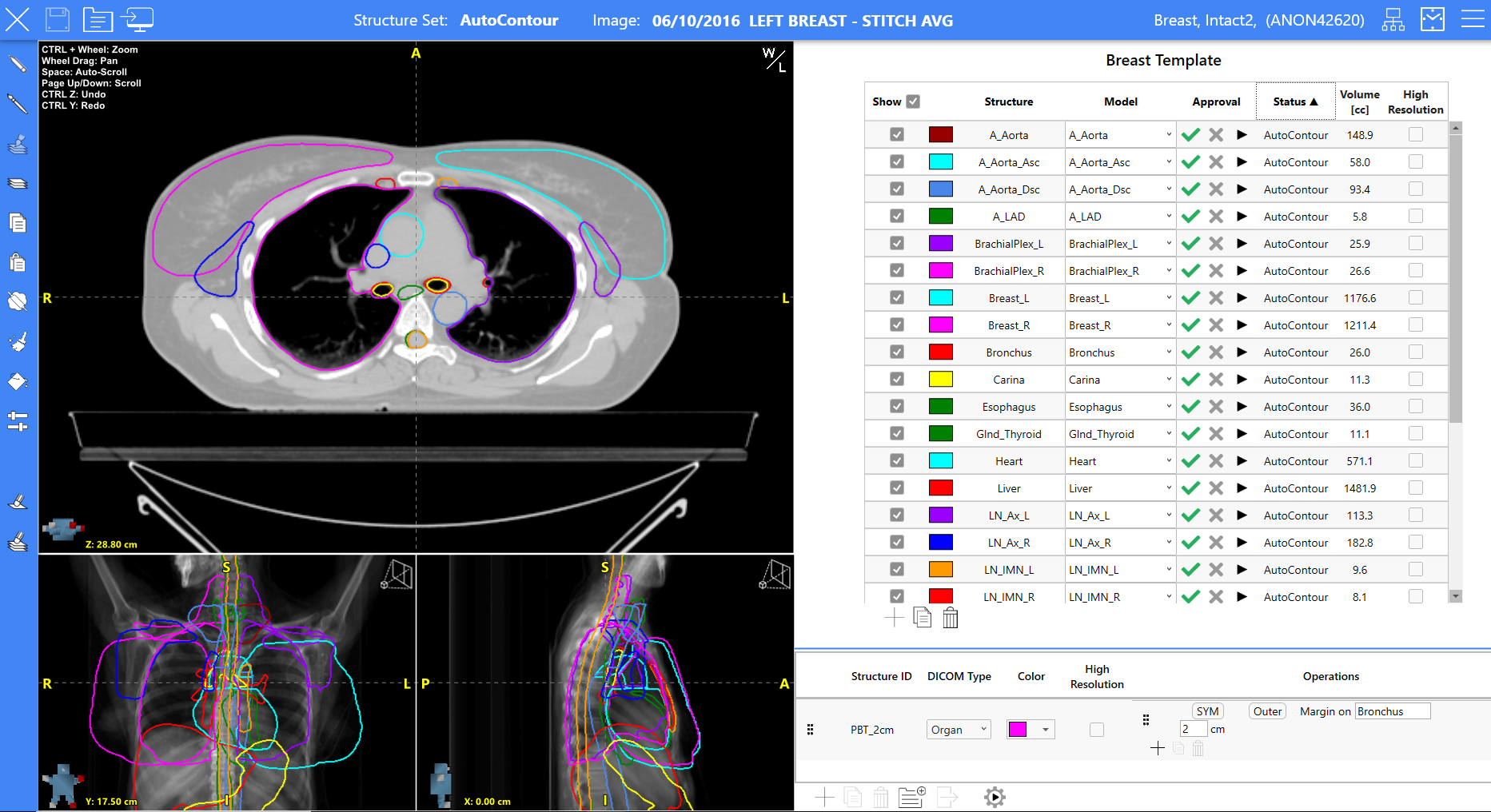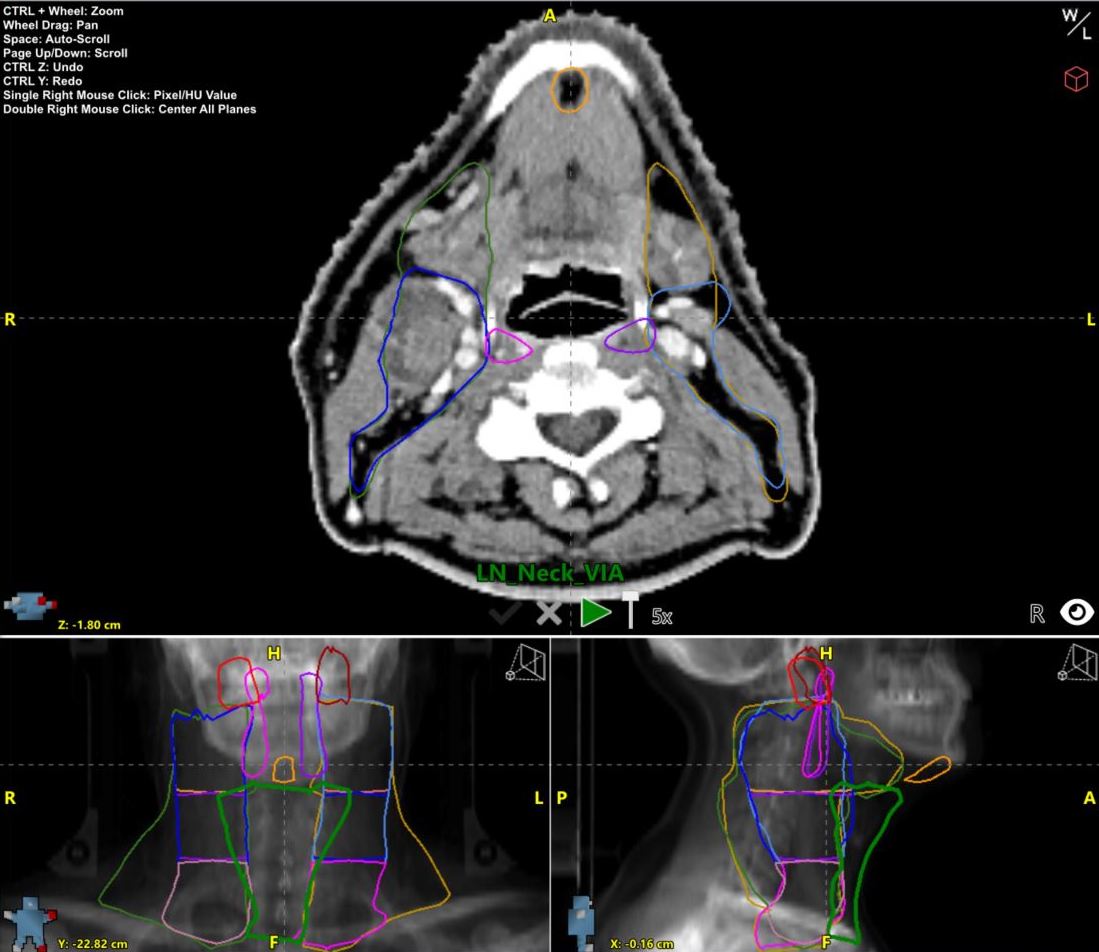Supported by:
In the precision-driven field of radiation oncology, the ability to deliver individualised and effective treatment plans while ensuring patient safety is crucial. As the field advances with complex treatment modalities and growing caseloads, the need to optimise treatment planning workflows becomes increasingly apparent. Automation has emerged as an essential tool offering significant improvements in both patient care are workflow efficiency. In this article, we explore the substantial benefits of automation in treatment planning workflows, illustrated through real-world case studies.

Figure 1.Experience precision and efficiency with automation, an important driving force behind improved patient care throughout the treatment planning process. AutoContour* is a leader in the autosegementation space and an important tool in Radformation’s user-friendly suite of automation software. Streamline your workflow while delivering efficient, precise, and high-quality treatment plans with automation from start to finish.
The Imperative for Automation
Radiation oncology relies heavily on the expertise of clinicians to develop personalised treatment plans that are both safe and effective. However, the complexity of modern treatment modalities, combined with surging patient caseloads and staffing shortages, poses a formidable challenge. Automation arrives as a game-changer, offering a solution that not only streamlines labour-intensive tasks but also enhances the quality of care.
Transform Treatment Planning with Automation
Automation extends its benefits to all areas of the treatment planning workflow, beyond just autosegmentation. A prime example of this is EZFluence*, Radformation's advanced forward planning software. EZFluence simplifies the planning of diverse treatment sites, from head to toe, ensuring standardisation and efficiency, particularly in field-in-field and electronic-compensator planning.
In a case study conducted at the University of Zurich, researchers investigated the impact of implementing EZFluence to simplify breast and whole-brain planning. EZFluence not only simplified the planning process, but it also markedly reduced dose distribution variability compared to manual planning, lowering the average hot spot and enhancing dose uniformity. This case study underscores how automation can lead to consistent and superior treatment plans, bolstering patient safety.
Standardisation for Enhanced Patient Care
Consistency is paramount in radiation therapy planning; even the slightest variations in dose delivery can significantly affect patient outcomes. Research by Fu et al. found that the introduction of automation in radiation therapy planning resulted in increased efficiency, reduced inter-observer variability, and improved consistency. Automation solutions, such as those provided by Radformation, ensure uniformity across the treatment planning process, fostering optimal patient outcomes.
Automation software also offers structured and precise checks and calculations that align with industry protocols and accommodate clinical preferences. This streamlines the plan evaluation process and maintains an unwavering focus on consistent quality. ClearCheck*, Radformation’s automated plan evaluation tool, led to a >30% increase in the number of constraints evaluated per plan. Through automation, each patient's care adheres to the highest quality benchmarks, enabling clinicians to be more efficient and save time.
Time Savings Across the Treatment Planning Workflow
A study by Doolan et al. highlighted the time efficiency of Radformation's autosegmentation tool, AutoContour*, which reduced contouring time by a remarkable 70% for head and neck cancer patients. Such significant time savings realized through automation allow medical physicists to dedicate more attention to complex aspects of treatment planning, ultimately shortening the overall planning duration.
Remarkably, this study also found that the accuracy of AutoContour’s segmentation Radformation's autosegmentation was on par with, or exceeded, the accuracy of manual contouring, indicating the potential for enhanced treatment quality without sacrificing precision.

Figure 2.AutoContour’s 200 CT and MR structure models include head and neck nodes, which Doolan et al. found reduced contouring time by 70% versus manual contouring. Utilising streamlined editing and review, users can start reviewing automated contours in under 30 seconds. Radformation’s suite of automation solutions enhance precision and efficiency through automation, providing high-quality treatment plans for patients.
Validation
A case study from the University of California San Diego’s implementation of ClearCheck resulted in a time savings of up to 26 hours over two weeks. The increased efficiency gains freed up time for clinicians to focus on aspects of plan generation and review that require experienced clinical judgement.
While these examples highlight time savings in specific workflow phases, the cumulative effect of automation throughout the entire process results in substantial time savings and high-quality treatment plans.
Standardise Excellence with Automation
Automation is revolutionising treatment planning workflows, offering unparallelled precision, efficiency, time savings, standardisation, and ultimately, patient care. As the field of radiation oncology evolves, harnessing the power of automation is not just a choice; it's a necessity to meet the demands of modern healthcare demands. Real-world case studies highlight the tangible benefits of automation’s transformative impact, demonstrating that automation is more than a tool—it's a catalyst for enhanced patient care.
*Disclaimer: Products not available in all markets.
For more information visit:
REFERENCES
Department of Radiation Medicine and Applied Sciences, UC San Diego School of Medicine, San Diego, California. How UCSD Leverages ClearCheck for Quick, Standardized Plan Reports. Radformation, 2021, https://21696034.fs1.hubspotusercontent-na1.net/hubfs/21696034/Resources/Case%20Studies/Case%20Study%2c%20ClearCheck%2c%20UCSD.pdf
Department of Radiation Oncology at the University of Zurich, Switzerland. University of Zurich Improves 3D Treatment Planning with EZFluence. 2020. Radformation, https://21696034.fs1.hubspotusercontent-na1.net/hubfs/21696034/Resources/Case%20Studies/Case%20Study%2c%20EZFluence%2c%20University%20of%20Zurich%20A4.pdf
Doolan, Paul J., et al. “A clinical evaluation of the performance of five commercial artificial intelligence contouring systems for radiotherapy.” Frontiers in Oncology, vol. 13, no. 13, 2023, https://www.frontiersin.org/articles/10.3389/fonc.2023.1213068
Fu, Yabo, et al. “A novel MRI segmentation method using CNN-based correction network for MRI-guided adaptive radiotherapy.” Medical Physics, vol. 45, no. 11, 2018, pp. 5129-5137. https://doi.org/10.1002/mp.13221